
CityRail was a passenger railway brand operated by the State Rail Authority from 1989 to 2003 and by RailCorp from 2003 to 2013 with services in and around Sydney, Newcastle and Wollongong, the three largest cities in New South Wales, Australia. It was established in January 1989 and abolished in June 2013 when it was superseded by Sydney Trains and NSW TrainLink.

The T sets, also referred to as the Tangara trains, are a class of electric multiple units that currently operate on the Sydney Trains network. Built by A Goninan & Co, the sets entered service between 1988 and 1995, initially under the State Rail Authority and later on CityRail. The T sets were built as "third-generation" trains for Sydney's rail fleet, coinciding with the final withdrawals of the "Red Rattler" sets from service in the late 1980s and early 1990s. The Tangaras were initially built as two classes; the long-distance G sets and the suburban T sets, before being merged after successive refurbishments.

The Main North Line is a major railway in New South Wales, Australia. It runs through Strathfield to Armidale. The line is the main line between Sydney and Armidale. As of 1988, the line closed progressively north of Armidale with services gradually withdrawn till 2004, with the main route between Sydney and Brisbane now the North Coast line.
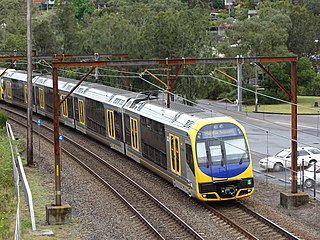
The Central Coast & Newcastle Line (CCN) is a NSW TrainLink passenger train service that runs along the Main North railway line in New South Wales, connecting the state's two largest cities, Sydney and Newcastle. The service runs from Central through to Broadmeadow on the Main North railway line to Newcastle Interchange on the Newcastle railway line, and services the Hawkesbury River region, the Central Coast and the city of Newcastle.

The South Coast Line (SCO) is an intercity rail service operated by NSW TrainLink that services the Illawarra region of New South Wales, Australia. The service runs from Central, and runs the entire length of the eponymous South Coast railway line to Bomaderry. The service also runs along the Eastern Suburbs railway line at peak hours and the Port Kembla railway line to Port Kembla. It is operated with NSW TrainLink H sets and Sydney Trains T sets, with Endeavour railcars operating the service on the non-electrified line between Kiama and Bomaderry.
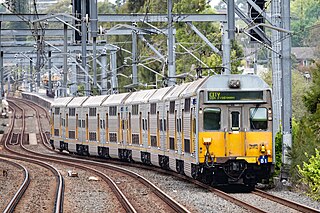
The K sets are a class of electric multiple units that currently operate on the Sydney Trains network. Built by A Goninan & Co, the K sets first entered service in 1981 operating under the State Rail Authority, and later CityRail. The carriages are of stainless steel, double deck construction and share much of their design with the older S sets. All of the 40 K sets originally built remain in service and are currently the oldest in the Sydney Trains fleet.
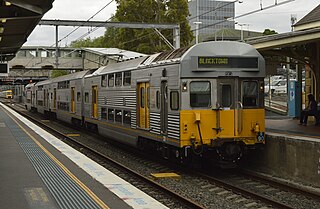
The S sets are a class of electric multiple units that operated on Sydney's suburban rail network from 1972 up until 2019. Originally entering service under the Public Transport Commission, the sets also operated under the State Rail Authority, CityRail and Sydney Trains. Prior to their retirement, the S sets were the last class in the Sydney Trains fleet to not be air-conditioned, earning them the nicknames "Tin cans" and "Sweat Sets". They were also nicknamed "Ridgys" because of their fluted ("ridged") stainless steel panelling; they shared this nickname with similar looking K sets and C sets. Their stainless steel appearance was also shared with the intercity V sets and the long retired U sets. The final sets were withdrawn from service in June 2019.
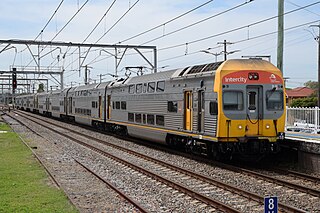
The V sets are a class of electric multiple units currently operated by NSW TrainLink. Built by Comeng between 1970 and 1989, the sets are of stainless steel construction, and are currently the oldest in the NSW TrainLink fleet. Initially introduced under the Public Transport Commission, only sets from 1977 and onwards remain in service, now operating on Intercity services to Lithgow and Newcastle.
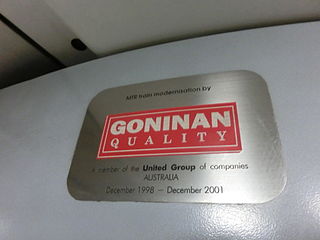
UGL Rail is an Australian rail company specialising in building, maintaining and refurbishing diesel locomotives, diesel and electric multiple units and freight wagons. It is a subsidiary of UGL and is based in Melbourne, with a staff of 1,200 across Australia and Asia. It operates factories in Broadmeadow, Maintrain Auburn, Spotswood and Bassendean. While it used to operate a factory in Taree, the plant was shut down and the equipment sold off.
The Sydney Trains fleet serves the metropolitan lines within Sydney, Australia. All of the rolling stock are double-deck electric multiple units and operate mainly as eight carriage sets.

The Hunter railcars, are a class of diesel multiple unit operated by NSW TrainLink on the Hunter Line in New South Wales, Australia. Built by UGL Rail between November 2006 and September 2007, they initially operated for CityRail.

Sydney, the largest city in Australia, has an extensive network of passenger and freight railways. The passenger system includes an extensive suburban railway network, operated by Sydney Trains, a metro network and a light rail network. A dedicated freight network also exists. Future expansion of the light rail network includes the Parramatta Light Rail. Existing light rail services are the Inner West Light Rail and the CBD & South East Light Rail.
The railways of New South Wales, Australia, use a large variety of passenger and freight rolling stock. The first railway in Sydney was opened in 1855 between Sydney and Granville, now a suburb of Sydney but then a major agricultural centre. The railway formed the basis of the New South Wales Government Railways. Passenger and freight services were operated from the beginning. By 1880, there was a half hourly service to Homebush.
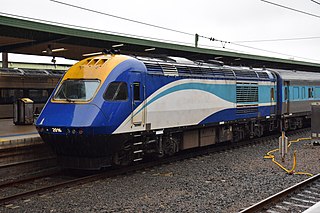
The New South Wales XPT is a class of diesel-powered passenger trains built by Comeng and ABB. Based on the British Rail-designed High Speed Train, each XPT set comprises two XP power cars in a push-pull configuration and, between them, between four and seven passenger carriages.

The U sets were a type of electric multiple unit (EMU) operated by the New South Wales Government Railways and its successors between September 1958 and November 1996. They were nicknamed U-boats.

NSW TrainLink is a train and coach operator in Australia, providing services throughout New South Wales and the Australian Capital Territory, along with limited interstate services into Victoria, Queensland and South Australia. Its primary intercity and regional services are spread throughout five major rail lines, operating out of Sydney's Central railway station.

Sydney Trains is the operator and brand name of the train network serving the Greater Sydney metropolitan area in New South Wales, Australia. The network is a hybrid urban-suburban rail system with a central underground core that covers 369 km (229 mi) of route length over 813 km (505 mi) of track, with 170 stations on eight lines.
The NSW TrainLink fleet of trains serves the areas outside Sydney, Australia, mainly interurban and interstate lines. The NSW TrainLink fleet consists of both diesel and electric traction, with the oldest of the fleet being the V sets and the youngest being the H sets.

The NSW TrainLink D sets, also referred to as the Mariyung trains, are a class of electric multiple units (EMU) being built to replace NSW TrainLink's Intercity EMU fleet. The trains will operate on services from Sydney to Newcastle, Lithgow and Kiama, allowing the retirement of NSW TrainLink's V set fleet, and freeing the H set fleet for reallocation to Sydney suburban services.

The Sydney Metro Metropolis Stock is a class of electric multiple units that operate on the Sydney Metro network. Built by Alstom as part of their Metropolis family, the trains are the first fully automated passenger rolling stock in Australia as well as the first single-deck trainsets to operate in Sydney since their withdrawal from the suburban rail network in the 1990s. A total of 176 carriages, making up 22 6-car sets, entered service in 2019 with the opening of the Metro North West Line. 23 more sets are gradually being rolled out for the City & Southwest extension, to commence service in 2024, expanding the Metropolis fleet to 45 sets.




















